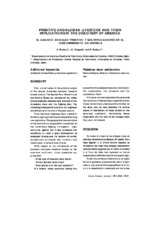Mostrar el registro sencillo del ítem
Primitive andalusian livestock and their implications in the discovery of America
| dc.contributor.author | Rodero Serrano, E. | es_ES |
| dc.contributor.author | Rodero Franganillo, Antonio | |
| dc.contributor.author | Delgado-Bermejo, J.V. | |
| dc.date.accessioned | 2010-05-17T07:15:20Z | |
| dc.date.available | 2010-05-17T07:15:20Z | |
| dc.date.issued | 1992 | |
| dc.identifier.issn | 1885-4494 | |
| dc.identifier.uri | http://hdl.handle.net/10396/3294 | |
| dc.description.abstract | First a brief review of the primitive origins of the diverse Andalusian domestic livestock breeds is done. The Spanish Pure Breed Horse and Merino Sheep are considered the oldest breeds classically characterized, followed by the Granadina Goat and the Fighting Bull. The remaining Andalusian Breeds were not organized and defined until the end of the past century. From historical beginning there existed in the Betic region a predominance of animal farming over agriculture. The geographical characteristics of the land and the depopulation occasioned by the continuous fighting, throughout eight centuries, against the Arabs produced the conditions to reach a good development of andalusian farming and, the isolation of certain populations produced the creation and maintenance of several local breeds. With respect to the introduction of the domestic european livestock breeds to the american continent, three questions are presented: - What type of livestock went there? - Where did they come from? - How spread it on the new continent? We answer these questions taking into account the three phases of american colonization: the exploration, the conquest and the colonization itself. Of course, we have emphasized those breeds that came from Andalusia, that crossed the Atlantic Ocean via the Canary Islands and the Antilles. At the same time we have sketched the diverse means of distribution of these breeds on the american continent, mentioning those responsible and the date of the voyages when they were introduced. | en |
| dc.description.abstract | Se revisa el origen de las antiguas razas de animales domésticos andaluzes. El caballo Pura Raza Español y el Ovino Merino Español se consideran las razas más antiguas clásicamente caracterizadas, seguidas por la Cabra Granadina y el Toro de Lidia. Las restantes no fueron organizadas ni definidas hasta fin del pasado siglo. Desde los comienzos históricos en la región bética la ganadería preponderaba sobre la agricultura. Las características geográficas de la tierra y la despoblación ocasionada por las luchas continuas contra los árabes a través de ocho siglos produjeron las condiciones para alcanzar un buen desarrollo de la ganadería andaluza y el aislamiento de ciertas poblaciones que determinaron la creación y el mantenimiento de varias razas locales. Con respecto a la introducción de las razas de ganado doméstico europeo en el continente americano se presentan 3 cuestiones: - ¿Qué tipo de ganado fue allí? - ¿De donde venían? - ¿Cómo se expandieron en el nuevo mundo? Se contesta a estas cuestiones tomando en cuenta las fases de la colonización americana: La exploración, la conquista y la colonización per se. Por supuesto, se enfatiza sobre aquellas razas que procedían de Andalucía y cruzaron el Océano Atlántico a través de las Islas Canarias y las Antillas. Asimismo se esquematizan las vías de distribución de estas razas en el continente americano, mencionando los responsables y las fechas de los viajes en que fueron introducidas. | es_ES |
| dc.format.mimetype | application/pdf | es_ES |
| dc.language.iso | eng | es_ES |
| dc.publisher | Universidad de Córdoba, Servicio de Publicaciones | es_ES |
| dc.rights | https://creativecommons.org/licenses/by-nc-nd/4.0/ | es_ES |
| dc.source | Archivos de zootecnia 41 (154), 383-400 (1992) | es_ES |
| dc.subject | Razas andaluzas | es_ES |
| dc.subject | Poblaciones americanas | es_ES |
| dc.subject | Ganado ovino | es_ES |
| dc.subject | Équidos | es_ES |
| dc.title | Primitive andalusian livestock and their implications in the discovery of America | en |
| dc.title.alternative | El ganado andaluz primitivo y sus implicaciones en el descubrimiento de América | es_ES |
| dc.type | info:eu-repo/semantics/article | es_ES |
| dc.relation.publisherversion | http://www.uco.es/organiza/servicios/publica/az/az.htm | es_ES |
| dc.rights.accessRights | info:eu-repo/semantics/openAccess | es_ES |

